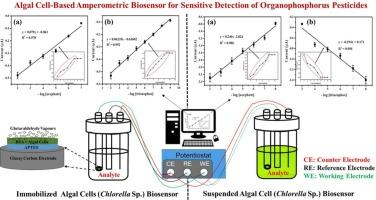新型小球藻安培生物传感器测定有机磷农药的研制
Q1 Environmental Science
引用次数: 0
摘要
有机磷农药在农业中广泛使用,对环境和人类健康造成严重危害。本研究提出了一种新型的含光合微藻小球藻(Chlorella sp.)的安培生物传感器,基于其对光系统II (PS II)的抑制相互作用来检测OPs。该生物传感器在悬浮和固定两种构型下使用计时电流技术进行了研究。优化实验结果表明,当pH为7时,藻悬液浓度为0.3 mL,固定化细胞体积为25 μL,电流响应最大。悬浮生物传感器对两种农药的电流趋势相反:对甲胺磷的电流降低,对三唑磷的电流增加,均在10−8 ~ 10−2 M的线性范围内,通过戊二醛交联固定在玻璃碳电极上后,两种分析物均显示出电流的一致降低,对甲胺磷的线性检测范围为10−7 ~ 10−2 M,对三唑磷的线性检测范围为10−9 ~ 10−2 M。这些差异强调了固定对分析物特异性反应模式的影响。这项工作证明了小球藻作为一种可持续的、无酶的OP检测生物传感元件的潜力,并突出了基于PS ii的生物传感在环境监测应用中的价值。双配置方法和分析物依赖趋势提供了对藻类电极相互作用的见解,为未来的实际样品验证和便携式传感器开发研究提供了基础。本文章由计算机程序翻译,如有差异,请以英文原文为准。

Development of a novel amperometric biosensor utilising Chlorella sp. for determination of organophosphorus pesticides
Organophosphorus pesticides (OPs) are extensively used in agriculture and pose serious environmental and human health risks. This study presents a novel amperometric biosensor incorporating Chlorella sp., a photosynthetic microalga, to detect OPs based on their inhibitory interaction with Photosystem II (PS II). The biosensor was investigated in both suspended and immobilized configurations using chronoamperometric techniques. Optimization studies revealed maximum current response at 0.3 mL algal suspension and 25 μL immobilized cell volume, both at pH 7. The suspended biosensor exhibited opposite current trends for the two pesticides: a decrease in current for acephate and an increase for triazophos, both over a linear range of 10−8 to 10−2 M. After immobilization via glutaraldehyde cross-linking on glassy carbon electrodes, both analytes showed consistent decreases in current, with linear detection ranges of 10−7 to 10−2 M for acephate and 10−9 to 10−2 M for triazophos. These differences underscore the impact of immobilization on analyte-specific response patterns. This work demonstrates the potential of Chlorella sp. as a sustainable, enzyme-free biosensing element for OP detection and highlights the value of PS II-based biosensing in environmental monitoring applications. The dual-configuration approach and analyte-dependent trends offer insights into algal-electrode interactions, providing a foundation for future research toward real-sample validation and portable sensor development.
求助全文
通过发布文献求助,成功后即可免费获取论文全文。
去求助
来源期刊

Bioresource Technology Reports
Environmental Science-Environmental Engineering
CiteScore
7.20
自引率
0.00%
发文量
390
审稿时长
28 days
 求助内容:
求助内容: 应助结果提醒方式:
应助结果提醒方式:


